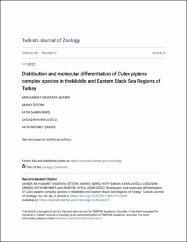Distribution and molecular differentiation of Culex pipiens complex species in the Middle and Eastern Black Sea Regions of Turkey

Göster/
Erişim
info:eu-repo/semantics/openAccessTarih
2022Yazar
Akıner, Muhammet MustafaÖztürk, Murat
Beriş, Fatih Şaban
Karacaoğlu, Çağasan
Şimşek, Fatih Mehmet
Uzun Akgeyik, Aytül
Üst veri
Tüm öğe kaydını gösterKünye
Akiner, M.M., Ozturk, M., Beris, F.S., Karacaoglu, C., Simsek, F. & Uzun Akgeyik, A. (2022). Distribution and molecular differentiation of Culex pipiens complex species in the Middle and Eastern Black Sea Regions of Turkey. Turkish Journal of Zoology, 46(2), 207-219. https://doi.org/10.55730/1300-0179.3049Özet
Culex pipiens species complex is commonly found in tropical and subtropical areas. Identification of species complexes and their spatial distribution patterns are fundamental steps needed to improve our understanding of arboviral disease circulation and their control. The specimens were differentiated using the Ace-2 gene, and the ecological forms of Culex pipiens were identified by analysis of the CQ11 microsatellite locus. Results showed that all sample points comprised of Culex pipiens s.s., and seven points contained Culex torrentium. Further, we determined that 22 haplotypes from five haplogroups were identified within the Ace-2 marker, and three haplotypes were contained within the CQ11 microsatellite locus. We determined that there was a high degree of the genetic flow of each marker between populations. In conclusion, Culex pipiens complex and sibling species were determined to be distributed throughout the coastal and inland parts of the Black Sea region in Turkey. The occurrence of two distinct ecological forms has the potential to create hybridization zones and a high risk of WNV transmission.

















